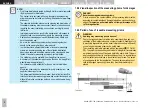
12
DEUTSCH
ENGLISH
FRANÇAIS
ITALIANO
ESPAÑOL
NEDERLANDS
PORTUGUÊS
SVENSKA
© HAAG‑STREIT AG, 3098 Koeniz, Switzerland ‑ HS‑Doc. no. 1500.7006000‑04270 – 2022 – 09
AT 900 model R and AT 900 model BQ
1. Swing the illumination apparatus to the left.
2. Release the tonometer from the dwell position to the right of the microscope,
and swing it forward until it locks in the measuring position.
3. From the left, bring the illumination apparatus into contact with the tonometer
bearer arm. This is the only illumination position in which both the patient’s left
and right eyes can be easily examined (no 60° position). This arrangement fa-
cilitates the splaying of the patient’s eyelids, should this be necessary for
measurement. The illumination of the applanated surface through the measur-
ing prism is practically reflection-free.
Observation:
with AT 900 model R in the left eyepiece
with AT 900 model BQ in the right eyepiece
AT 900 model T
For an examination through the tonometer’s left or right eyepiece, the angle
between the illumination apparatus and the microscope should be approx. 60° so
that the image is bright and reflection-free. Alternatively: lighting through the meas-
uring prism at approx. 10°.
AT 870
1. Swing the sensor arm with the measuring prism into the beam path of the mi-
croscope and the illumination.
2. The angle between the illumination apparatus and the microscope should be
approximately 60° so that the image appears bright and free of reflections. Al-
ternatively: lighting through the measuring prism at approx. 10°.
3. Set the measuring drum to the first calibration line.
4. Set a mid-level illumination intensity.
WARNING!
Measurements through observation with the wrong eyepiece adjustment
can lead to false results.
6.6 Measuring correctly
NOTE!
Make sure that the measuring arm of the tonometer can move freely and
is not hindered by the patient's eyelashes, beard, etc.
1. Immediately before taking measurements, the patient should close his eyes
briefly so that the cornea becomes sufficiently moistened with fluorescein-im-
pregnated tear fluid.
2. By moving the slit lamp, the measuring prism comes into contact with the
centre of the cornea over the pupillary area.
3. During contact, the cornea's limbus takes on a bluish glow. This glow can be
best observed with the naked eye from the opposite side of the illumination ap-
paratus.
4. When the limbus glows, stop moving the slit lamp immediately.
5. After contact is made, viewing is conducted through the microscope. The uni-
form pulsation of the two semi circular fluorescein bands, which could be of dif-
ferent sizes in drum setting 1 depending upon inter-ocular pressure, shows
that the tonometer is in the right measuring position.
6. Any necessary corrections are done using the slit lamp control lever, until the
flattened surface is observed in the form of two semicircles of similar size in
the middle of the visual field (A).
7. Smaller changes in the depth of the slit lamp using the control lever do not af-
fect the size of the semicircles.
8. The pressure on the eye is increased by turning the tonometer knob until the
inner borders of both fluorescein bands just touch = correct setting (B).
9. When the eye pulsates, both semi circles cross over each other.
10. The width of the fluorescein band around the contact point of the measuring
prism should be about 1/10 of the diameter of the applanation surface (0.3
mm).
11. Reading the scale value:
• Reading the value
• and multiplying by 10
• yields the inter-ocular pressure in mm Hg







































